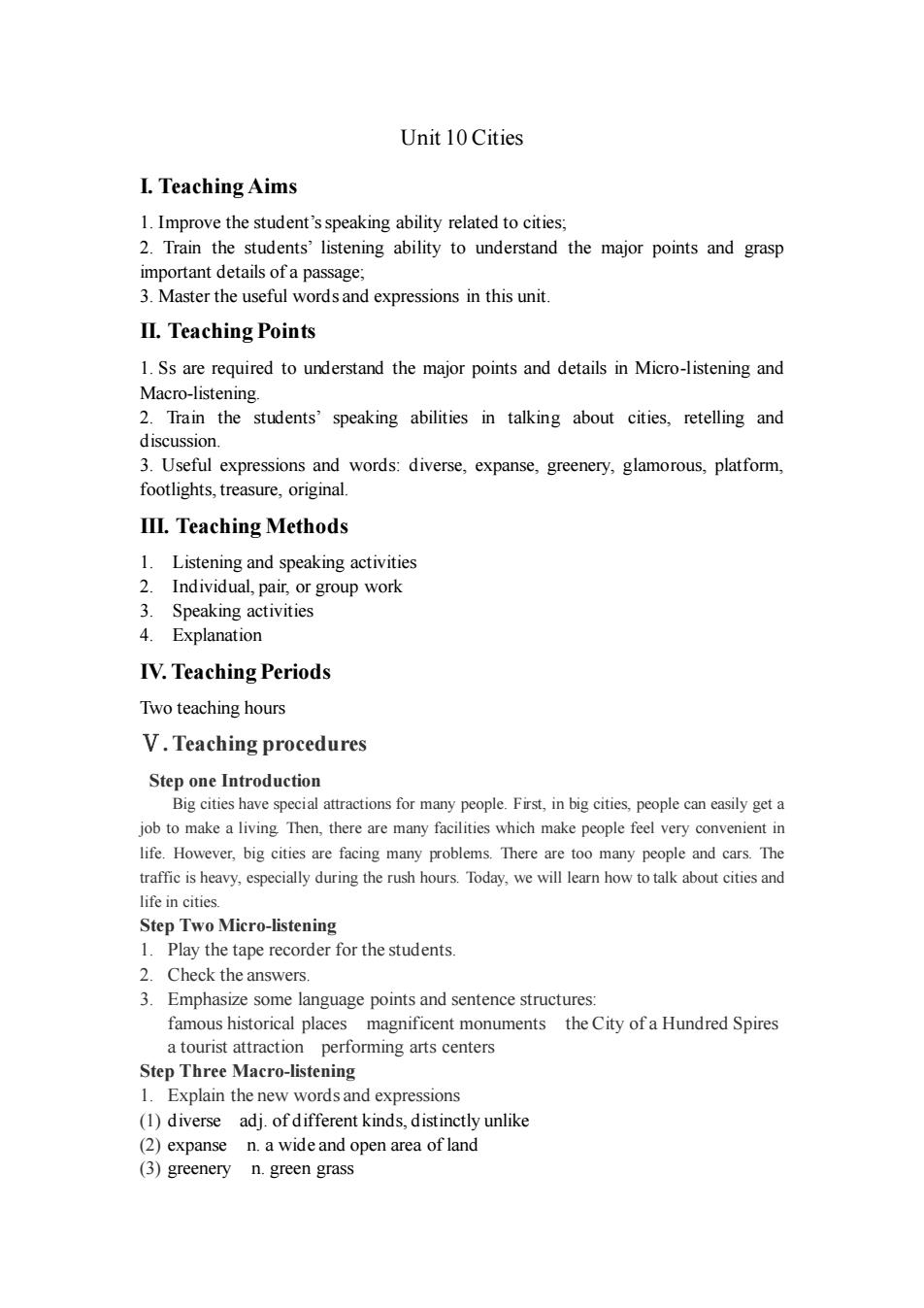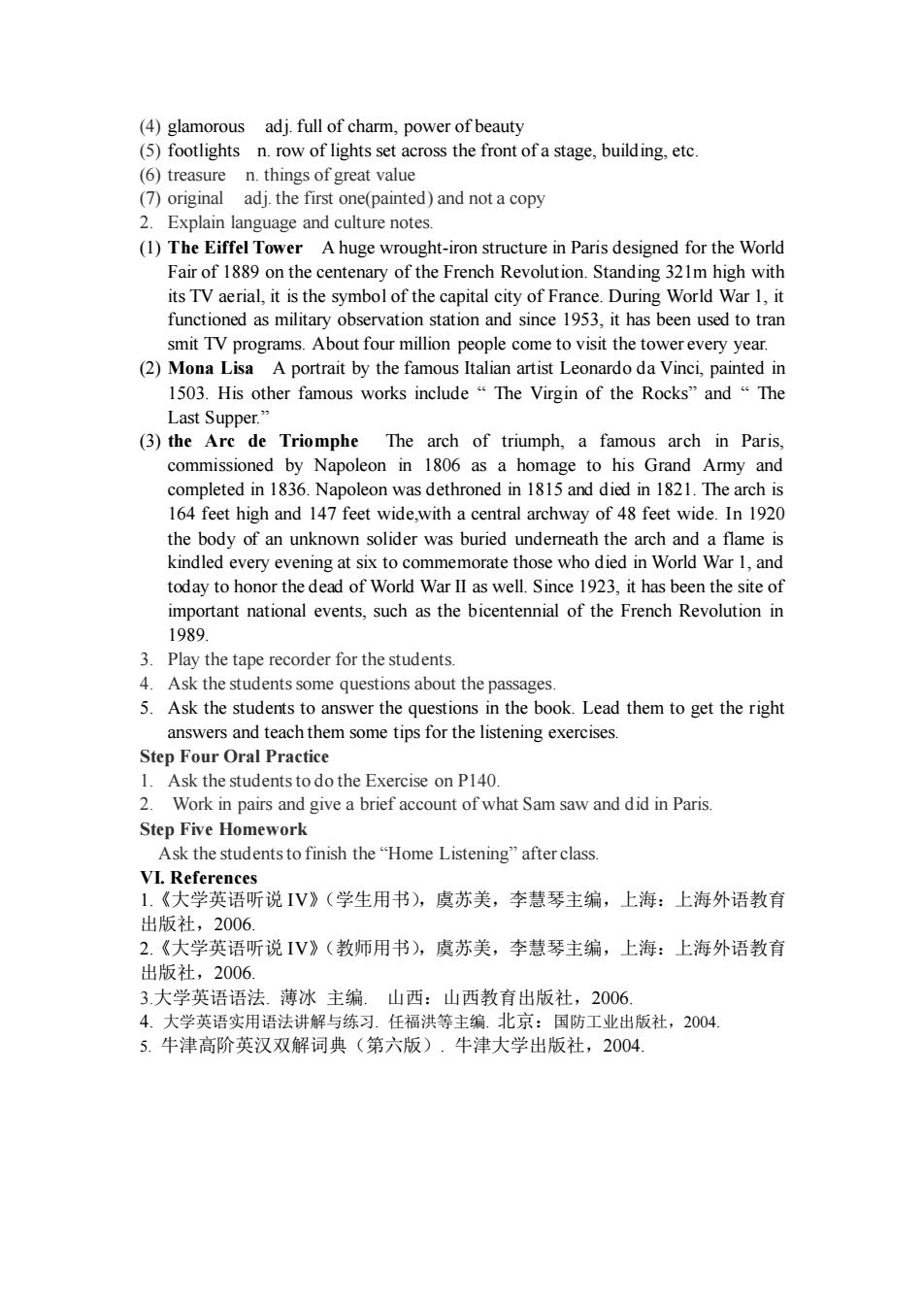
Unit 10 Cities I.Teaching Aims 1 Improve the student's speaking ability related to cities 2.Train the students'listening ability to understand the major points and grasp II.Teaching Points 1.Ss are required to understand the major points and details in Micro-listening and Macro-listening 2.Train the students'speaking abilities in talking about cities,retelling and discussion. 3.Useful expressions and words:diverse,expanse,greenery,glamorous,platform, footlights,treasure,original III.Teaching Methods 1.Listening and speaking activities 2. Individual,pair,or group work 3.Speaking activities 4.Explanation IV.Teaching Periods Two teaching hours V.Teaching procedures Step one Introduction Big cities ha job to make a living Then.there are many facilities which make people feel very convenient i life.However,big cities are facing many problems.There are too many people and cars.The traffic is heavy,especially during the rush hours.Today,we will learn how to talk about cities and life in cities Step Two Micro-listening 1 Play the tape recorder for the students 2.Check the answers 3.Emphasize some language points and sentence structures: famous historical places magnificent monuments the City of a Hundred Spires a tourist attraction Explain the new words and expressions (1)diverse adj.ofdifferent kinds,distinctly unlike (2)expanse n.a wide and open area of land (3)greenery n.green grass
Unit 10 Cities I. Teaching Aims 1. Improve the student’s speaking ability related to cities; 2. Train the students’ listening ability to understand the major points and grasp important details of a passage; 3. Master the useful words and expressions in this unit. II. Teaching Points 1. Ss are required to understand the major points and details in Micro-listening and Macro-listening. 2. Train the students’ speaking abilities in talking about cities, retelling and discussion. 3. Useful expressions and words: diverse, expanse, greenery, glamorous, platform, footlights, treasure, original. III. Teaching Methods 1. Listening and speaking activities 2. Individual, pair, or group work 3. Speaking activities 4. Explanation IV. Teaching Periods Two teaching hours Ⅴ. Teaching procedures Step one Introduction Big cities have special attractions for many people. First, in big cities, people can easily get a job to make a living. Then, there are many facilities which make people feel very convenient in life. However, big cities are facing many problems. There are too many people and cars. The traffic is heavy, especially during the rush hours. Today, we will learn how to talk about cities and life in cities. Step Two Micro-listening 1. Play the tape recorder for the students. 2. Check the answers. 3. Emphasize some language points and sentence structures: famous historical places magnificent monuments the City of a Hundred Spires a tourist attraction performing arts centers Step Three Macro-listening 1. Explain the new words and expressions (1) diverse adj. of different kinds, distinctly unlike (2) expanse n. a wide and open area of land (3) greenery n. green grass

(4)glamorousadj.full of chamm,power of beauty (5)footlights n.row of lights set across the front ofa stage,building,etc (6)treasure n.things of great value (7)original adj.the first one(painted)and nota copy 2.Explain language and culture notes. (1)The Eiffel Tower A huge wrought-iron structure in Paris designed for the World Fair on the centenary of the Fren ch Revo olution.Standing 321m TVsthe bo h ior Frince Dung Workd functioned as military observation station and since 1953,it has been used to tran smit TV programs.About four million people come to visit the tower every year. (2)Mona Lisa A portrait by the famous Italian artist Leonardo da Vinci,painted in 1503.His other famous works include"The Virgin of the Rocks"and"The ast Supper (3)the Arc de Triomphe The arch of triumph,a famous arch in Paris, commissioned by Napoleon in 1806 as a homage to his Grand Army and completed in 1836.Napoleon was dethroned in 1815 and died in 1821.The arch is 164 feet high and 147 feet wide,with a central archway of 48 feet wide.In 1920 the e body of an unknown solider was buried undemeath the arc nd a flame kindled every evening at six to commemorate those who died in World War 1,and today to honor the dead of World War II as well.Since 1923,it has been the site of important national events,such as the bicentennial of the French Revolution in 1989. 3 5.Ask the students to answer the questions in the book.Lead them to get the right answers and teach them some tips for the listening exercises. Step Four Oral Practice Ask the students to do the Exercise on P140. Work in pairs and give a brief account of what Sam saw and did in Paris Step Five Homework Ask the students to finish the"Home Listening"after class. VI.References 1.《大学英语听说V》(学生用书),虞苏美,李慧琴主编,上海:上海外语教育 出版社.2006 2.《大学英语听说IV》(教师用书),虞苏美,李慧琴主编,上海:上海外语教育 出版社,2006 3.大学英语语法.薄冰主编.山西:山西教育出版社,2006. 4.大学英语实用语法讲解与练习.任福洪等主编。北京:国防工业出版社,2004 5.牛津高阶英汉双解词典(第六版),牛津大学出版社,2004
(4) glamorous adj. full of charm, power of beauty (5) footlights n. row of lights set across the front of a stage, building, etc. (6) treasure n. things of great value (7) original adj. the first one(painted) and not a copy 2. Explain language and culture notes. (1) The Eiffel Tower A huge wrought-iron structure in Paris designed for the World Fair of 1889 on the centenary of the French Revolution. Standing 321m high with its TV aerial, it is the symbol of the capital city of France. During World War 1, it functioned as military observation station and since 1953, it has been used to tran smit TV programs. About four million people come to visit the tower every year. (2) Mona Lisa A portrait by the famous Italian artist Leonardo da Vinci, painted in 1503. His other famous works include “ The Virgin of the Rocks” and “ The Last Supper.” (3) the Arc de Triomphe The arch of triumph, a famous arch in Paris, commissioned by Napoleon in 1806 as a homage to his Grand Army and completed in 1836. Napoleon was dethroned in 1815 and died in 1821. The arch is 164 feet high and 147 feet wide,with a central archway of 48 feet wide. In 1920 the body of an unknown solider was buried underneath the arch and a flame is kindled every evening at six to commemorate those who died in World War 1, and today to honor the dead of World War II as well. Since 1923, it has been the site of important national events, such as the bicentennial of the French Revolution in 1989. 3. Play the tape recorder for the students. 4. Ask the students some questions about the passages. 5. Ask the students to answer the questions in the book. Lead them to get the right answers and teach them some tips for the listening exercises. Step Four Oral Practice 1. Ask the students to do the Exercise on P140. 2. Work in pairs and give a brief account of what Sam saw and did in Paris. Step Five Homework Ask the students to finish the “Home Listening” after class. VI. References 1.《大学英语听说 IV》(学生用书),虞苏美,李慧琴主编,上海:上海外语教育 出版社,2006. 2.《大学英语听说 IV》(教师用书),虞苏美,李慧琴主编,上海:上海外语教育 出版社,2006. 3.大学英语语法. 薄冰 主编. 山西:山西教育出版社,2006. 4. 大学英语实用语法讲解与练习. 任福洪等主编. 北京:国防工业出版社,2004. 5. 牛津高阶英汉双解词典(第六版). 牛津大学出版社,2004